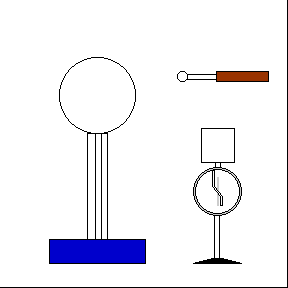| a. A hollow cylinder is connected to a Van De Graaff generator. Pith balls hanging on the outside fly up wildly but pith balls hanging from the inside barely stir. |

|
|
b. Faraday Cage - -When a Van de Graaff is turned on, it will affect an electroscope at a distance of a meter or more. However, when a metal cage is put over the electroscope, the electroscope is not affected, even if the apparatus is moved close enough so sparks jump to the cage.
|
 |
 |
| c. Faraday Pail - -a small metal can is placed on the electroscope. A "charge carrier" (a small metal ball on an insulated rod) is used to transfer charge from an electrophorus plate or Van de Graaff sphere to the inside of the can. Since this charge immediately flows to the outside of the can, several more "spoonfuls" of charge can be added to the can in this manner, as shown by the increasing deviation of the electroscope leaves or needle. This, then, is the principle of the Van de Graaff generator - - charge is continually carried up by the belt to the center of the sphere, whence it accumulates on the outside. |

|
 |
d. A very definitive demonstration of Gauss's Law is provided by a large hollow sphere with an opening in the side and an electrode in the center. The hollow sphere is charged by connecting a conducting rod from the center electrode to a Van de Graaff generator. Charge can now be removed from the outside of the hollow sphere by touching it with a charge carrier. The charge carrier is touched to an electroscope to show the presence of charge. But if the charge carrier is touched to the center electrode of the charged hollow sphere, no charge can be removed. All the charge has flowed to the outside of the sphere. (The insulated metal ball of the charge carrier should be touched very gently to the electroscope; otherwise, the indicating needle will be banged up, confusing the students.)
|





